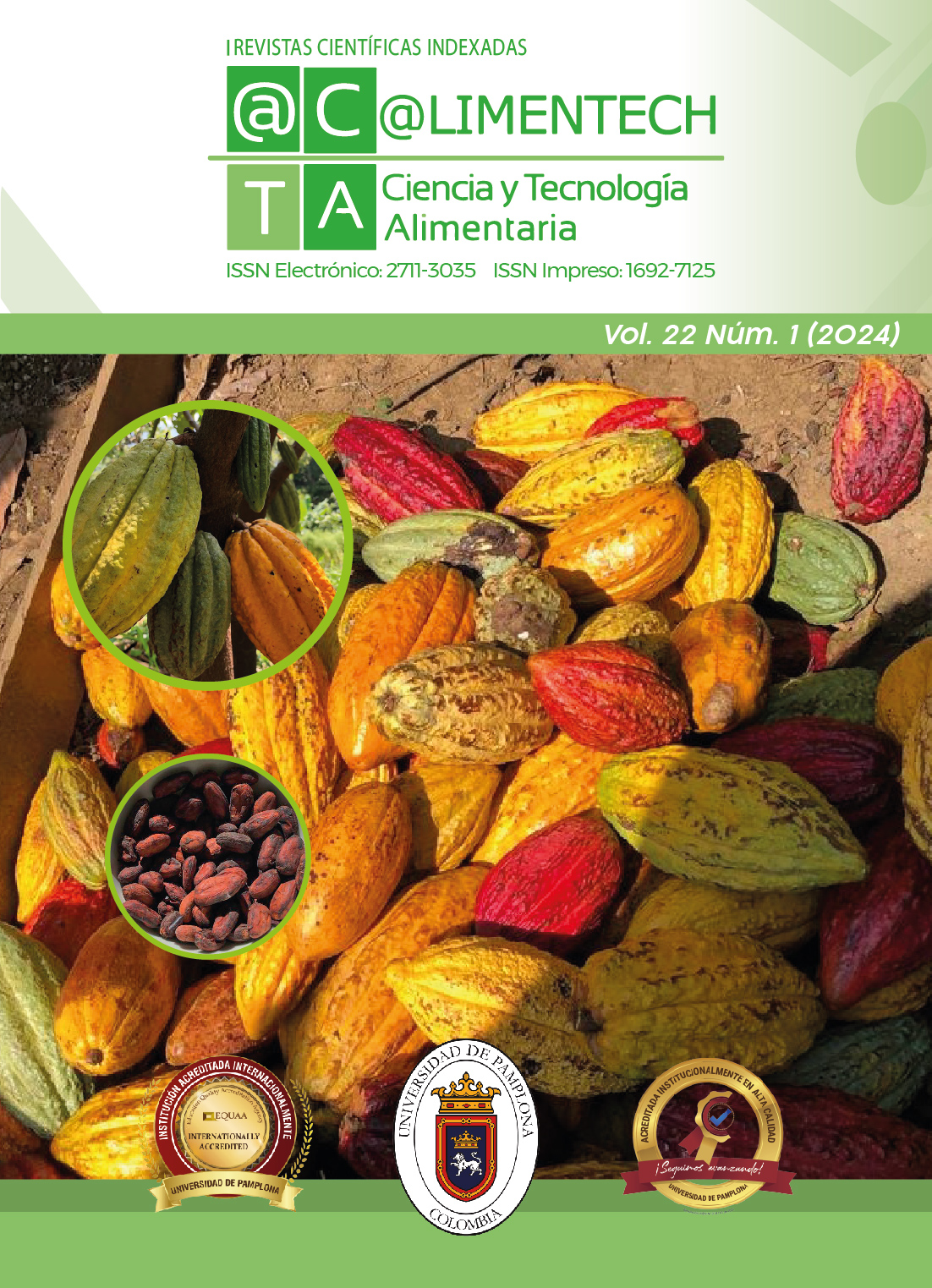Evaluación de las características sensoriales de un queso fresco con aceite microencapsulado de microalga parachlorella kessleri
DOI:
https://doi.org/10.24054/limentech.v22i1.2861Palabras clave:
ácidos grasos n -3, alimento funcional, matriz alimentaria, microalgas, microencapsulamientoResumen
Esta investigación tuvo como objetivo principal la evaluación integral de una matriz láctea enriquecida con aceite microencapsulado extraído de la microalga Parachlorella kessleri. Se establecieron tres objetivos específicos para abordar diferentes aspectos del proyecto. En primer lugar, se centró en la formulación y estandarización de la matriz láctea con la adición de aceite microencapsulado de Parachlorella kessleri. A través de un enfoque experimental, se logró establecer una formulación óptima (es decir valores altos en microencapsulado y bajo en sal) y las condiciones de fabricación necesarias para producir queso fresco enriquecido con este aceite microencapsulado, implicando la manipulación de variables clave en la producción. Posteriormente se enfocó en la evaluación de las características nutricionales y fisicoquímicas del producto resultante. Se analizaron parámetros como la humedad, sólidos totales, pH y perfil de ácidos grasos para comprender mejor la composición nutricional del queso fresco con la adición del aceite microencapsulado, destacando su contribución a los ácidos grasos esenciales, como los omega-3. El último aspecto de esta investigación fue la evaluación sensorial del queso fresco enriquecido. A través del análisis sensorial, se evaluaron los atributos de sabor, textura y olor del producto final, proporcionando una comprensión precisa de la percepción sensorial por parte de los consumidores, lo que es esencial para evaluar su aceptación en el mercado. Este artículo presentará los resultados de la evaluación sensorial que respaldaron la viabilidad de la inclusión del aceite microencapsulado de Parachlorella kessleri en la matriz láctea. El queso fresco enriquecido mantuvo características organolépticas similares a las de un queso fresco tradicional, lo que sugiere su potencial como una opción atractiva y saludable para los consumidores en busca de productos lácteos innovadores y nutritivos.
Descargas
Referencias
Cai, M. (2019). Fruit-based functional food. In The Role of Alternative and Innovative Food Ingredients and Products in Consumer Wellness (pp. 35–72). Elsevier. https://doi.org/10.1016/B978-0-12-816453-2.00002-4
Dueñas, H., Bermello, S., Burgos, G., & Alcívar, U. (2020). Encapsulado de aceite esencial de albahaca morada (Ocimum sanctum) aplicado como agente antimicrobiano, en queso criollo y pasteurizado. Polo Del Conocimiento, 5(8), 819–834. https://doi.org/10.23857/pc.v5i8.1625
Feliu, M. S., Fernández, I., & Slobodianik, N. (2021). Importancia de los ácidos grasos omega 3 en la salud. Actualización En Nutrición, 22(1), 25–32. https://doi.org/10.48061/san.2021.22.1.25
Flórez, D., Contreras-Pedraza, C., Escobar, S., & Rodríguez, J. (2022). Key drivers for non-centrifugal sugar cane research, technological development, and market linkage: A technological roadmap approach for Colombia. Sugar Tech, 25(2), 373–385. https://doi.org/10.1007/s12355-022-01200-9
Garnica Corrales, F. L., & Vera Romero, J. M. (2022). Estudios de perfil textura y color en emulsiones cárnicas tipo premium sometidas a campos ultrasónicos. Revista @limentech, Ciencia y Tecnología Alimentaria, 20(1), 21–30. ISSN Impreso 1692-7125, ISSN Electrónico 2711-3035.
Gómez, B., Sepulveda, J., Alzate, A., Herrera, J., & Rojano, B. (2020). Evaluación oxidativa, microbiológica, sensorial y perfil de ácidos grasos de un yogur con ácido docosahexaenoico (DHA) extraído de aceite de microalgas. Rev Chil Nutr, 47(4), 568-579. https://doi.org/10.4067/S0717-75182020000400568
González, R. E., Pérez, J. M., & Tarón, A. D. (2015). Efecto de lactobacillus delbrueckii sobre las propiedades texturales de geles binarios de goma gelana. Revista @limentech, Ciencia y Tecnología Alimentaria, 13(2), 195–204. ISSN 1692-7125.
Hernández, C., Ilina, A., Ventura, J., Belmares, R., Contreras, J., Álvarez, G., & Martínez, J. (2016). La microencapsulación de bioactivos para su aplicación en la industria. Instituto Cubano de Investigaciones de Los Derivados de La Caña de Azúcar Cuba ICIDCA, 50, 12–19. http://www.redalyc.org/articulo.oa?id=223148420003
Hernández, E. (2005). Evaluación Sensorial. Bogotá D.C.: Universidad Nacional Abierta y a Distancia.
Jeong, H., Lee, Y., Ganesan, P., & Kwak, H. (2017). Food science of animal resources ties of Queso Blanco cheese supplemented with powdered microcapsules of tomato extracts. Korean Journal for Food Science of Animal Resources, 37(3), 342–350. https://doi.org/10.5851/kosfa.2017.37.3.342
Lamichhane, P., Kelly, A., & Sheehan, J. (2018). Symposium review: Structure-function relationships in cheese. Journal of Dairy Science, 101(3), 2692–2709. https://doi.org/10.3168/jds.2017-13386
Ortiz, N., Ochoa, L., Gonzáles, S., Rutiaga, O., & Gallegos, J. (2021). Avances en las investigaciones sobre la encapsulación mediante gelación iónica: una revisión sistemática. Tecnológicas, 24(52), 1–19. https://revistas.itm.edu.co/index.php/tecnologicas/article/view/1962/2123
Pacheco, M. (2018). Determinación de la concentración mínima de cloruro de sodio que se puede reducir en un queso fresco sin que sea perceptible para los consumidores utilizando un umbral de diferencia y su efecto sobre el desuerado y perfil de textura. Repositorio.Sibdi.Ucr.Ac.Cr, 1–107. http://repositorio.sibdi.ucr.ac.cr:8080/jspui/bitstream/123456789/5974/1/42588.pdf
Pajaro, N., Méndez, G., Fortich, R., Torrenegra, M., & Vega, J. (2020). de Cinnamomum verum J. mediante secado antioxidante activity. Revista Cubana De Farmacia, 51(2), 1–15. https://revfarmacia.sld.cu/index.php/far/article/view/227/133
Posada, S., & Gómez, B. (2012). Posibilidades de penetración al mercado colombiano con alimentos funcionales. Repositorio EIA, 90. http://repository.eia.edu.co/bitstream/11190/377/1/ADMO0800.pdf
Ramírez, J., Aguirre, J., Aristizabal, V., & Castro, S. (2016). La sal en el queso: diversas interacciones. Agronomía Mesoamericana, 28(1), 303. https://doi.org/10.15517/am.v28i1.21909
Vega García, L., Garay Ruiz, I., Diéguez, A. H., & Ganado Miguélez, E. (2021). Beneficios de los ácidos grasos esenciales. El Farmacéutico, 596, 24–29.
Vega, T. L., Márquez, C. A., de la Cruz, A. B., Torres, C. A., & Ricardo, P. A. (2019). Determinación del efecto antagónico de bacteriófagos sobre géneros de bacterias potenciales causantes de mastitis bovina (Staphylococcus spp., Streptococcus spp., Corynebacterium spp., Pseudomonas spp., y Escherichia coli) en Pamplona, Norte de Santander. Ciencia y Tecnología Agropecuaria, 4(2), 82–85. https://ojs.unipamplona.edu.co/index.php/rcyta/article/view/1040/1125
Villada Castillo, D. C., Ochoa Flórez, D. E., & Pabón Mora, C. (2022). Desarrollo y evaluación sensorial de una bebida a base de mango (Mangifera indica) y moringa (Oleífera). Revista @limentech, Ciencia y Tecnología Alimentaria, 20(2), 119–131. ISSN Impreso 1692-7125, ISSN Electrónico 2711-3035.
Descargas
Publicado
Número
Sección
Licencia
Derechos de autor 2024 @limentech, Ciencia y Tecnología Alimentaria

Esta obra está bajo una licencia internacional Creative Commons Atribución-NoComercial 4.0.








